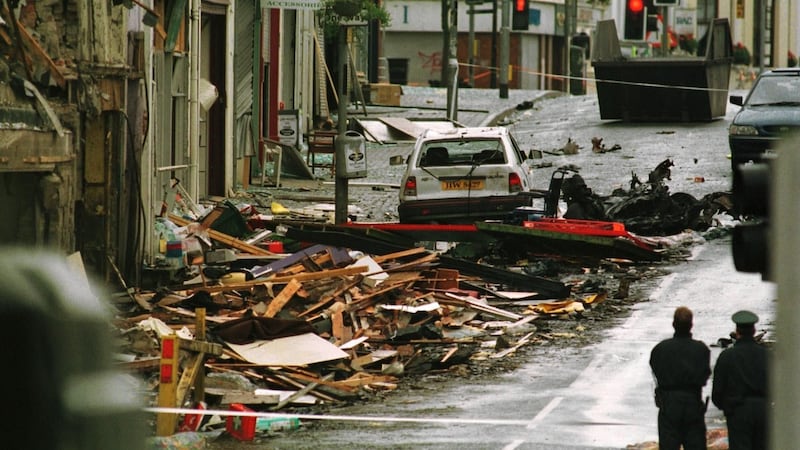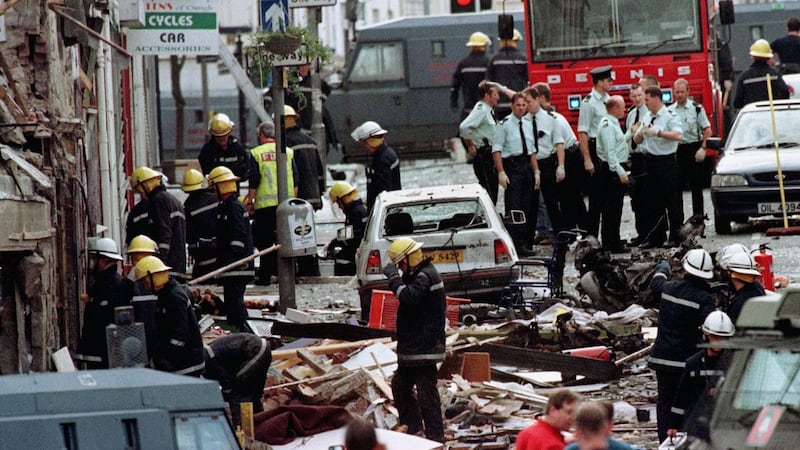Looking up the main street of Omagh, Co Tyrone, it is easy to miss Market Street Arcade.
A narrow alleyway roughly a metre wide and a few metres long, it was to this spot that many of the victims of the Omagh bomb were first brought.
"We laid the first one here, then put them across in rows," former police officer Richard Scott recalls.
His voice catches and he pauses. “We continued on until this was completely full of bodies.”
Only half an hour before, the street had been full of Saturday afternoon shoppers. A warning of a bomb at the courthouse meant that the other end of the street had been evacuated and members of the public were directed – unwittingly – towards the bottom of the town. A car containing a 1,000lb device had been left there by the Real IRA.
At 3.10pm on August 15th, 1998, it exploded. The final death toll was 31 – 29 men, women and children, and unborn twins, of all ages, religions and backgrounds. It was the largest loss of life from any single atrocity of the Northern Ireland Troubles.
Like many people that August afternoon, Kevin Skelton and his family had come into Omagh to buy school uniforms.
He had left his wife, Mena, and their three teenage daughters shopping for school shoes.

Skelton points to the street. “That’s the spot there, where the car was.”
A glass obelisk engraved with a heart now stands in its place; a plaque on the wall beside marks the “act of terror” which “killed thirty-one people, injured hundreds, and killed forever the lives of many”.
Skelton was in the shop next door. “Bang. The bomb went off.”
‘Dead in the rubble’
“I found Mena lying dead in the rubble. The first person to arrive was a fireman I knew, and once he lifted Mena’s arm and dropped it, I knew.”
His immediate concern was his daughters. Fifteen-year-old Tracy had been knocked unconscious, but he later found her kneeling beside her mother.
“Unbeknown to me Shauna [13] was already away to hospital. I thought she was dead.
“I was digging, I thought she was lying underneath her mother. I was pulling things away and there were certain things you lifted; you might find an arm and it not connected to anything. It was awful.
“The smell of burning flesh, that’s something I have to live with, and the screaming. I can still hear it.”

Ulsterbus district inspector Paddy McGowan arrived just minutes after the explosion. Running towards the site of the bomb, he met a group of children who he later learned were from Buncrana, Co Donegal. Three children from the town – James Barker, Oran Doherty and Sean McLaughlin – as well as a Spanish boy, Fernando Blasco Baselga, and his teacher Rocio Abad Ramos, who had been staying with them, would be among the dead.
“They were all running, and crying, and blood was coming from some of them.
“There were bodies everywhere, and the buildings were nearly all demolished. Everything was in complete turmoil.
“People had started to cover up the bodies. There was a shop that sold bed linen and it had been blown out onto the street, and people were using duvet covers to cover them over.”
Seeing one of his buses at the corner of Market Street, he waved the driver over and began helping the wounded onto the bus.
“Those who were able to walk got on the bus, and others we carried them on. I didn’t realise it at the time, but some of them had actually lost limbs.”
Makeshift mortuary
Scott had also heard the bomb go off. He and a colleague grabbed first aid kits from the police station, and then drove into the town centre.
“For a strange moment it all went so quiet. I looked up and there was a window in one of the buildings and you could just see the window coming down as if in slow motion and crashing.
“It went silent, and then everybody started to scream again because they thought it was another bomb going off.”
Tyrone County Hospital was only a few minutes away from the town centre. The senior surgeon on call was Dr Domingos Pinto.
"I opened the double doors to A&E and it was absolute bedlam. It was like a battlefield. People were everywhere, even on the floor, or looking for their relatives.
“I went in and the first thing I noticed was a child being resuscitated. It was a little baby. It died.
“Another person, the nurse couldn’t feel a pulse. I went to her, and she had died.
“I realised we were going to have casualties and I asked a nurse to clear a ward and make that a mortuary because I didn’t know how many people were going to come in, but we had to treat the dead with dignity.”
Walking wounded
The outpatient department was opened to treat the walking wounded, and doctors began assessing patients and arranging, where necessary, for them to be sent to other hospitals.
Dr Pinto operated on patients until 10 o'clock that night; below, in A&E, was the hospital's medical director, Dr Clive Russell.
“Most of our job was triaging and deciding who needed to go and who needed to stay, and that went on for hours and hours.
“I remember going out about 4 or 5 o’clock in the afternoon to the helipad and I could see three helicopters, one on the ground and two above, all waiting to take people away.”
Following an appeal for help broadcast on television and radio, doctors, nurses and others had been arriving to offer their services.
“We had the most amazing response,” says Dr Russell. “I remember walking down the corridor and being stopped by this man who asked could he help. It turned out he was a coastguard, and we really needed someone who was able to talk down helicopters; he was fantastic.”
Beautiful green eyes
Work was also beginning to identify the dead and injured. Dr Russell recalls a couple who kept asking him to look for a young girl.
“I checked and checked and I said no, I hadn’t seen her, but she had been brought in dead, she was only 12 or 13, but we had set up a temporary mortuary and I didn’t know until much later that her remains were upstairs.”
Among those who had come to the hospital to look for their loved ones was Michael Gallagher. He had last seen his son Aidan earlier that afternoon, when he had gone into town to buy a pair of jeans.

All that night and into the next afternoon, families were brought to a temporary mortuary at the nearby army base to identify the dead. It was there that Michael Gallagher identified his son Aidan. “I had to go home and tell my wife and two girls that Aidan wasn’t coming home,” says his father.

The Barker family, from Buncrana, were among the last to arrive; James’s mother, Donna-Maria, had been at home when the police came to her door to say James was missing.
“I remember going to see him and he was in this tiny room, and I remember wanting to put my arms round him and kiss him and an army guy put up his hands to stop me and I remember shouting, ‘you’re not going to stop me holding my son’.
“He was draped in something green, it looked like a green curtain over him, and on his face was just a white handkerchief.
“I took it off and I remember saying why did they not wash his face, because it was covered in blood, but his eyes, I remember thinking what beautiful emerald green eyes he had.
“I knew he had green eyes but I never realised how beautiful they were.”
Nobody convicted
In the 20 years since, nobody has been convicted of the murders at Omagh. Some relatives continue to campaign for justice; others believe that they – and the town – have been let down by politicians and by all those who promised that Omagh would be looked after. Others – particularly those who were injured or who responded on the day – continue to deal with the trauma, both physical and mental, it inflicted on their lives. Yet others are hopeful and say that while their loved ones will never be forgotten, the town itself has moved on.

In the week ahead, the focus in Omagh – and elsewhere – will be on remembrance. Services are to be held on Sunday, and on the 20th anniversary of the explosion on Wednesday; smaller memorials are planned for, among others, Omagh hospital and Buncrana.
Now living in England, James Barker’s family had moved to Buncrana to escape the Troubles. Among his mother’s memories are of a smiling boy who loved football – especially Chelsea FC – and who had been full of excitement at the thought of a trip to Omagh.
“Four days before he was killed we were walking on the beach in Buncrana,” she says. “He was so happy.”
“[My other son] Oliver was running ahead, and James was in the water, and he turned round and said, ‘Mum, this is the best time of my life.’”










